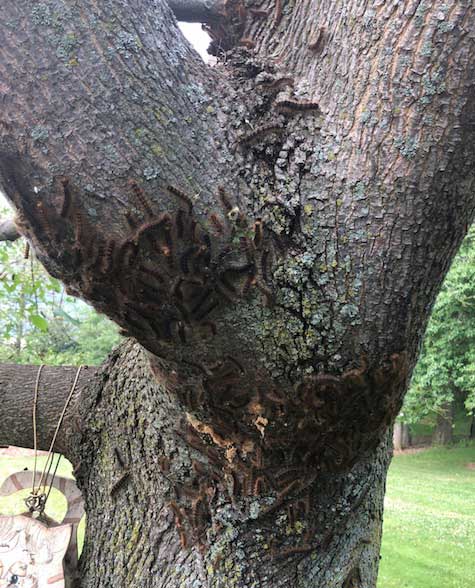KNOWLESVILLE – The Orleans County Cornell Cooperative Extension office is receiving high volumes of calls from homeowners concerned about the defoliation of trees and shrubs by small hairy caterpillars.
These pests are the larval stage of the Gypsy Moth Lymantria dispar, an invasive species that can cause massive defoliation in home landscapes and woodland forests.

Photo by Kathy Brooks – Gypsy Moth caterpillars congregate on an affected tree in Albion.
The Gypsy Moth was accidentally introduced to the US in the late 1800s and has become widespread across North American ever since. Gypsy Moth is one of the most destructive forest pests in the country.
The moth goes through four distinct life stages: egg, larvae, pupae, and adult – usually just one generation per year. The larval stage is the only one that causes damage. The adult moth doesn’t feed at all, its only purpose is to reproduce and lay eggs. But the larvae can cause significant damage while it is active.
Caterpillars of the Gypsy Moth are hairy and can be identified by the pairs of blue and rust colored spots running the length of their bodies. The caterpillars go through 5 or 6 molts (or instars), during which they feed voraciously on shade trees and some shrubs.
The majority of the feeding happens in the last two instars, which usually occurs in late June to early July. The caterpillars prefer tree species such as oak, birch, apple, willow and linden, However they are not host-specific and will feed on a variety of other species of trees and shrubs.
After the caterpillars complete their development, they drop to the ground and seek a place to pupate. After about 10-14 days in the resting pupal stage, the adult moths emerge. Adult moths only have about two weeks to reproduce and lay eggs before dying.
Deciduous trees that suffer a small amount of defoliation will usually not suffer long-term. Trees that suffer complete or near complete defoliation will be stressed, which can lead to secondary problems, but they should be able to send out a second flush of leaves and recuperate a bit before the growing season is over.
Keep defoliated/refoliated trees evenly watered throughout the rest of the growing season and avoid fertilizer until next spring. Evergreen trees such as pine and spruce can die from one single season of defoliation, so if you’re noticing heavy feeding on these trees and they are valuable to you in your landscape, you should consider treating for the caterpillars.
Many homeowners wonder what they can do to manage exploding populations of hungry caterpillars. If the caterpillars are under 1-inch long, the recommended pesticide to use is one that contains a naturally occurring bacteria: Bacillus thuringensis var.kurstaki (Btk).
Once the caterpillars enter later life stages, Btk is less effective. There are other insecticides labelled for use against Gypsy Moth caterpillars as well. However, when the caterpillars are longer than 1 inch and they are found feeding high in the canopy of shade trees, treatment can be difficult and a call to a tree service is often recommended. When using any pesticides, the label is the law and must be followed exactly.
Homeowners can also try banding methods of management – tying a piece of folded burlap around the affected tree trunks. In later life stages, the caterpillars typically move down the trees during the day then climb back up at night to feed. The folded burlap will trap caterpillars between the layers and homeowners can then destroy them.
After the caterpillars finish feeding, the best option for control is destroying egg masses to reduce populations the following year. Look for the tan colored, fuzzy splotches on tree trunks, buildings, fences or other objects anytime from fall until April. Remove the egg masses by scraping them off into a bucket of soapy water and leaving for a few days.
For more information check out the Cornell Insect Diagnostic Lab factsheet or contact Orleans County CCE Horticulture educator Katie Oakes by calling 585-798-4265 ext 125 or emailing klo54@cornell.edu.
Sources: Cornell Insect Diagnostic Lab
UConn Ladybug Blog “Gypsy Moth”
University of Wisconsin-Madison Extension Factsheet on Gypsy Moth




